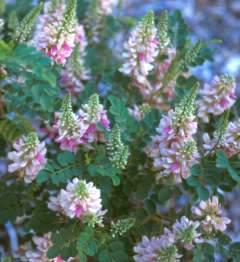Indigofera jucunda
Indigofera jucunda Schrire
Family: Fabaceae
Common names: river indigo, showy indigo (Eng.), rivierverfbos, pronkverfbos (Afr.), umsipane (Xhosa), umnukambiba, isiphungo (Zulu)
SA Tree No: 226.4
Introduction
This beautiful plant has had the misfortune of being known by an incorrect name for many years, resulting in some confusion about its identity. But whether you know it as Indigofera jucunda or I. frutescens it is a lovely addition to the garden.

Description
Description
Indigofera jucunda is a graceful shrub or small tree, 2-4 m tall, often scrambling. The main stem is greyish brown and the leaves are dark green and compound with leaflets, occurring in pairs of 4 to 7 plus a terminal one. Flowers are small, pink or white and sweetly scented. They are borne in showy dainty spikes up to 5cm long during summer, from December through to April. Smooth, reddish-brown cylindrical pods with 8 to 10 seeds each, occur from May to July.

Conservation Status
Status
Indigofera jucunda is not endangered, and is assessed as Least Concern (LC) on the Red List of South African Plants.
Distribution and habitat
Distribution description
Indigofera jucunda occurs naturally in riverine forest or scrub and on sandstone outcrops in the Eastern Cape and southern Kwazulu-Natal.
Derivation of name and historical aspects
History
This plant was formerly known by the name Indigofera cylindrica. Botanical investigation in the 1990s found that the name Indigofera cylindrica had been incorrectly applied to this species and that the name was synomous with Indigofera frutescens, which is a quite different plant from the Cedarberg fynbos with bright pink-purple flowers in a lax racemes. The confusion arose because the Cedarberg plant with the purple flowers was named both Indigofera frutescens and I. cylindrica by different botanists. Then the name I.cylindrica was misapplied to our plant by another botanist. When this was found out, i.e. that both I. frutescens and I.cylindrica rightfully apply to the Cedarberg plant (I.frutescens being the current valid name), our plant was given a new name I.jucunda. Confusion still occurs over the name of this plant and you may find it incorrectly labelled in the nursery trade, as well as in some botanical gardens.
The name Indigofera means 'bearing indigo', Indigo referring to the dye and the Latin fero meaning 'to bear'. Indigo is one of the oldest colouring agents known to man. It is Indigofera tinctoria, a species from the East Indies, that yields the dye Indigo, and has a long history in trade. Indigo is one of the oldest colouring agents known to man. The leaves are the main source of the dye but roots are sometimes also used. It gives a light purple to mauve colour or sometimes dark brown or grey, depending on the dyeing time. Natural indigo was originally produced for commercial use through a complicated process of aerobic fermentation and agitation, followed by heating the precipitated sludge, which was then formed into cakes for shipment.
The species name jucunda is Latin and means 'pleasing'. The misapplied name cylindrica means 'cylindrical' referring to the shape of the seed pods, while frutescens means 'shrubby' or 'bushy'.
Indigofera is a large genus of over 800 species, mostly herbs and undershrubs, with two tree-like species. They are to befound in all tropical and subtropical countries with over 200 speciesin South Africa alone.
Members of the pea family include a wide range of plants including economically important crops such as beans, peas and clover, as well as herbs, shrubs and a few beautiful flowering trees. The characteristic sweet-pea flowers of this family have a large upper petal (the standard), two side petals (wings) and two lower petals that are fused to forma 'keel' enfolding the stamens and pistil.
Ecology
Ecology
Several species of butterflies including the Common Lucerne Blue, Lampides boeticus, and the Drakensberg Blue, Lepidochrysopsniobe, breed on indigoferas.

Uses
Use
Indigofera jucunda is used in traditional medicine to treat worms in humans and animals, and coughs and colds.
Other species of Indigofera have medicinal uses such as helping with infertility and menstrual cramps. One is even believed to be able to change the sex of a baby before birth. Another species has its twigs used as toothbrushes and its sap used as mouthwash.
Growing Indigofera jucunda
Grow
Indigofera jucunda is not a striking plant, but it is dainty andshowy when in flower, making it an interesting garden subject.
It is semi-deciduous and prefers a warm, sunny position in the garden, although it will tolerate semi-shade conditions. It grows easily in good, loamy soil.
It will grow easily from seed that should be sown in spring and takes from 3 to 6 weeks to germinate. The seedlings should be pricked out and planted in individual containers until they are about 20 cm in height. They will flowerin the 2nd or 3rd year. These plants may also be propagated by means of cuttings.
Credits
Cherise Viljoen
Kirstenbosch National Botanical Garden
January 2001
updated by Yvonne Reynolds, 2008
Plant Attributes:
Plant Type: Shrub, Tree
SA Distribution: Eastern Cape, KwaZulu-Natal
Soil type: Sandy, Loam
Flowering season: Early Summer, Late Summer
PH: Acid, Neutral
Flower colour: Pink, Cream
Aspect: Full Sun, Morning Sun (Semi Shade), Afternoon Sun (Semi Shade)
Gardening skill: Easy
Special Features:
Horticultural zones










Rate this article
Article well written and informative
Rate this plant
Is this an interesting plant?
Login to add your Comment
Back to topNot registered yet? Click here to register.